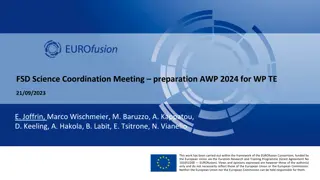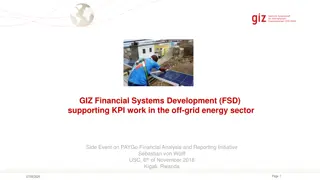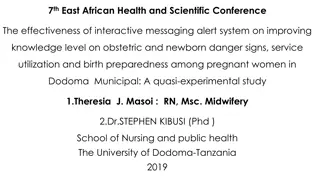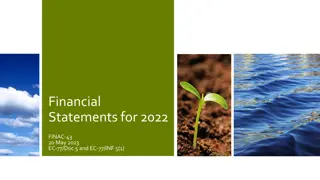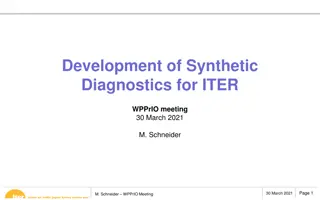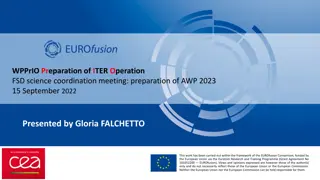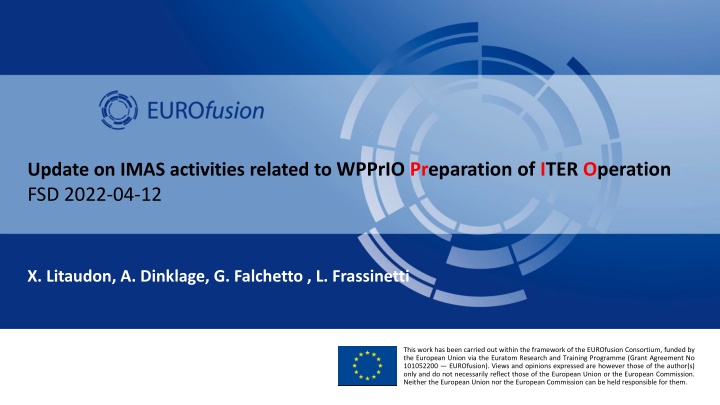
Update on IMAS Activities for ITER Operation Preparation
Discover the latest developments in IMAS activities related to the preparation of ITER operation. Learn about ongoing projects, plans, and collaborations within the EUROfusion Consortium funded by the European Union. Follow the progress in developing simulation tools, database formats, and integrating advanced diagnostics for ITER operation enhancement.
Download Presentation

Please find below an Image/Link to download the presentation.
The content on the website is provided AS IS for your information and personal use only. It may not be sold, licensed, or shared on other websites without obtaining consent from the author. If you encounter any issues during the download, it is possible that the publisher has removed the file from their server.
You are allowed to download the files provided on this website for personal or commercial use, subject to the condition that they are used lawfully. All files are the property of their respective owners.
The content on the website is provided AS IS for your information and personal use only. It may not be sold, licensed, or shared on other websites without obtaining consent from the author.
E N D
Presentation Transcript
Update on IMAS activities related to WPPrIO Preparation of ITER Operation FSD 2022-04-12 X. Litaudon, A. Dinklage, G. Falchetto , L. Frassinetti This work has been carried out within the framework of the EUROfusion Consortium, funded by the European Union via the Euratom Research and Training Programme (Grant Agreement No 101052200 EUROfusion). Views and opinions expressed are however those of the author(s) only and do not necessarily reflect those of the European Union or the European Commission. Neither the European Union nor the European Commission can be held responsible for them.
PrIO and IMAS activities IMAS activities IMAS database format under discussion 2 X. LITAUDON | IMAS FSD Meeting | 12 04 2022
PrIO Plans: more under WPPrIO wikipages: Preparation of ITER Operation Work Package - EUROfusion MediaWiki (euro-fusion.org) Development of plasma breakdown/burn-through simulation tools and application for ITER operation Make the IMAS interface of DYON (with ACH support and link with TSVV11) and map data for coupling to the High Fidelity Pulse Simulator (TSVV11) Finalise the adaptation of the breakdown simulation workflow CREATE-BD/BKD0/GRAY to IMAS (with ACH support) Fibre Optic Current Sensor (FOCS) First release of the simulation code (Python) for the Fiber Optics Current Sensor synthetic diagnostics compatible to IMAS (2022) and finalization in 2023 ITER - FILD: simulations in support to ITER design and synthetic diagnostic Assess the work to be done for mapping the FILDSIM s inputs and outputs into IMAS (2022) IR temperature synthetic diagnostic for ITER real-time application and offline analysis Integrating IR synthetic diagnostics and associated tools into IMAS as long term activity ( 2023 and beyond) Databases Cf next slides 3 X. LITAUDON | IMAS FSD Meeting | 12 04 2022
EUROfusion multi-machine databases and IMAS L. Frassinetti This work has been carried out within the framework of the EUROfusion Consortium, funded by the European Union via the Euratom Research and Training Programme (Grant Agreement No 101052200 EUROfusion). Views and opinions expressed are however those of the author(s) only and do not necessarily reflect those of the European Union or the European Commission. Neither the European Union nor the European Commission can be held responsible for them. 4 X. LITAUDON | IMAS FSD Meeting | 12 04 2022
EUROfusion tokamak multi-machine databases Three EUROfusion tokamak multi-machine databases (so far): Confinement (coordinator E. Peluso) Disruptions (coordinator A. Pau) Pedestal (coordinator L. Frassinetti) with definitions presented and discussed in the ITPA-PEP meeting Strong interaction with ITPA (IO) Plan 2022 and beyond Store all the databases in IMAS on the EUROfusion Gateway L. Frassinetti et al. 5 X. LITAUDON | IMAS FSD Meeting | 12 04 2022
Work done so far Script to transfer the 0D variables into IMAS is ready Language: python Latest update: November 2021 to reflect the latest IMAS version About 175 parameters for each entry. For each parameter, the IMAS summary IDS contains: o */value: value of the parameter o */value_error_upper: uncertainty on the parameter o */source: metadata containing the source of the parameter The script has been tested for the pedestal database: 3 test shots from JET have been stored in IMAS on the Gateway: /g2lfrass/public/imasdb/pedestalDB_test_nov2021/3/0/ 3 test shots from TCV have been stored in IMAS on the Gateway: /g2mvan/public/imasdb/pedestalDB_test_nov2021/3/0 Full TCV pedestal database has been stored in IMAS on the Gateway: /g2mvan/public/imasdb/TCV_PedestalDB/3/0 The full list of IMAS pedestal variables can be found on the WPPrIO wikipages: https://iterphysicswiki.euro-fusion.org/images/5/59/Pedestal_db_variables_list_on_wiki.pdf Full pedestal database can be transferred at any time (pending inclusion of Peeling-Ballooning stability data). L. Frassinetti et al. 6 X. LITAUDON | IMAS FSD Meeting | 12 04 2022
2022 and beyond plans Transfer the whole 0D pedestal database into IMAS Start testing the transfer to IMAS for the confinement and the disruption databases Include profiles in the database and extend the scripts to transfer 1D data to IMAS Store all the databases in IMAS on the EUROfusion Gateway L. Frassinetti et al. 7 X. LITAUDON | IMAS FSD Meeting | 12 04 2022
IMAS version of the stellarator confinement DB A. Dinklage This work has been carried out within the framework of the EUROfusion Consortium, funded by the European Union via the Euratom Research and Training Programme (Grant Agreement No 101052200 EUROfusion). Views and opinions expressed are however those of the author(s) only and do not necessarily reflect those of the European Union or the European Commission. Neither the European Union nor the European Commission can be held responsible for them. 8 X. LITAUDON | IMAS FSD Meeting | 12 04 2022
Bringing International Stellarator/Heliotron Confinement DataBase (ISCDB) into Interface Data Structures [1/2] The ISCDB is a joint database effort conducted within the Coordinated Working Group in the IEA Technology Collaboration Programme on Stellarators and Heliotrons. inclusion of confinement data from Wendelstein 7-X from its initial campaigns with a limiter and a test- divertor unit. Ongoing activity to map the ISCDB data into the IMAS data structure Written document has been elaborated recently on the mapping by Andreas Dinklage (Dated: April 1, 2022) Description and definition of all IMAS data Lastest version 27 of ISCDB that includes latest W7-X discharges Unique opportunity to contribute to joint tokamak-stellarator confinement physics with the same language ! 9 X. LITAUDON | IMAS FSD Meeting | 12 04 2022
Bringing International Stellarator-Heliotron Profile Confinement DataBase (ISCDB) into Interface Data Structures [2/2] New metadata: version of IMAS, data dictionary, access layer parameters for the ISS04 scaling law of the energy confinement time already incorporated (e.g. summary.local.r_eff_norm_2_3.plateau_factor) Lacking in IMAS - to be agreed in expert meetings - physics definitions: geometry (RGEO, elongation, ) days_since_evap, , PFLUX, peaking_Te, tauL/R, tauPulse, nTtau, detachment indicator, confinement mode indicator? Expected confinement time from scalings requires processing of Ip (from IMAS) or q23 (1/rotational transform) at r/a = 2/3 Dictionary IMAS, ITPA DB5.2.3., ISCDB underway Next step: transfer documentation of W7-X data for CICLOP performance database update (including Kikuchi-diagram update) 10 X. LITAUDON | IMAS FSD Meeting | 12 04 2022
CICLOP database: Fusion triple product versus high performance duration ITER Reduction of fusion performance: two orders of magnitude when increasing the plasma duration from one second to 100s (JET DTE2 progress up to 5s not included )
CICLOP database: Core ion temperature/pressure versus duration ? 30s Detached plasma LPO in dominant electron-heating modes at reduced density (current drive issues for tokamaks ) but with low Tio 1 to 3 keV / low pressure for discharges above 100s: progress should be made to increase ion temperature at high density ??

